|
|
|
On the Birds of the Philippine Islands
W.R. Ogilvie Grant
Field notes: John Whitehead
2 colour plate (Cinnyris whiteheadi and Stoparola nigrimentalis / Zosterornis whiteheadi and Chimarrhornis bicolor): J.G. Keulemans
Ibis: Volume 36, Issue 4, pages 501-522
1894
Opening lines: "Mr. Whitehead's second collection from the Philippines arrived a few weeks ago (on the 15th of June), and is rich in new species and in interesting forms of all kinds of bird-life. Starting from Manila on the 1st of January, Mr. Whitehead did not return till the 3rd of April, and the results of this second trip have surpassed my most sanguine expectations. There are examples of no less than 19 very distinct new species, one of which (Zosterornis whiteheadi) I have been obliged to refer to a new genus, most nearly allied to the Timaliine forms Cyanodernia and Mixornis. But undoubtedly the most interesting of Mr. Whitehead's discoveries is a small resident Crossbill (Loxia luzoniensis), most nearly allied to the little Himalayan form (L.himalayma)."
|
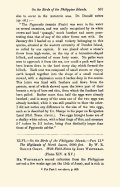
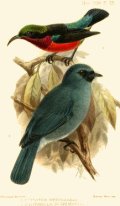 |
|
On some Birds collected on Byingyi Mountain, Shan States, Burma
Eugene W. Oates
Colour plate (Ixulus clarki): J.G. Keulemans
Ibis: Volume 36, Issue 4, pages 478-484
1894
Opening lines: "Byingyi Mountain rises abruptly from the plains of Upper Burma and forms a portion of the intricate system of hills and mountains which constitutes the Shan States. It is situated in about north latitude 20 and east longitude 96. It rises to a height of 6200 feet. Immediately to the southeast of Byingyi lies the State of Karennee, a country which was partially explored by Major W. R. Wardlaw-Ramsay some years ago, and an account of the birds of which appeared in 'The Ibis'."
|
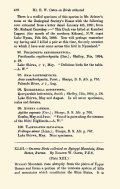
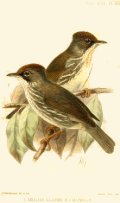 |
|
Third List of the Birds collected by Mr. Alexander Whyte, F.Z.S., in Nyasaland
Captain G.E. Shelley
Colour plate (Agapornis lilianae): J.G. Keulemans
Ibis: Volume 36, Issue 4, pages 461-478
1894
Opening lines: "In the present communication I give an account of the contents of several boxes of birdskins which have been forwarded to Mr. Sclater by Mr. H. H. Johnston, C.B., F.Z.S., H.M. Commissioner for British Central Africa, during the past few months, and have been submitted to me for examination. As in the case of the previous collections, the specimens have all been obtained and prepared by Mr. Alexander Whyte, F.Z.S., Naturalist on Mr. Johnston's Staff, who is usually resident at Zomba, the seat of government."
|
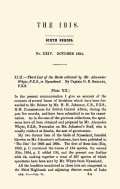
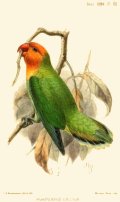 |
|
Descriptions de quelques Espèces nouvelles d‘ Oiseaux du Pérou central
Comte Hans de Berlepsch et Jean Stolzmann
Colour plate (Leptosittaca branickii): J.G. Keulemans
Ibis: Volume 36, Issue 3, pages 385-405
1894
Opening lines: "M. Jean Kalinowski, correspondant du Museum Branicki de Varsovic, ayant acheve son exploration du Perou central pour entreprendre ses recherches en Bolivie, nous nous proposons de publier une liste complete des oiseaux trouves par cet infatigable voyageur. Pour le moment, nous nous bornerons a donner les descriptions de plusieurs especes qui, selon nous, sont encore inconnues."
|
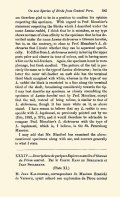
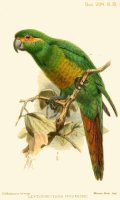 |
|
On the Crimson–headed Wood-Partridge (Hæmatortyx sanguiniceps)
W.R. Ogilvie Grant
Colour plate (Hæmatortyx sanguiniceps): J.G. Keulemans
Ibis: Volume 36, Issue 3, pages 374-378
1894
Opening lines: "Of the many wonderful new forms of bird-life which have been discovered in Borneo during recent years, none is more interesting and striking than this Wood-Partridge, the male of which is now figured for the first time. Although this rare bird was originally described by Dr. Sharpe fifteen years ago (Ibis, 1879, p. 266), from a female specimen obtained by Mr. W. H. Treacher near the Lawas River, no additional specimens reached this country till November 1891, when Mr. C. Hose had the good fortune to secure a second female on the moss-clad summit of Mount Dulit at an elevation of 5000 feet. Finally, in 1893, one of Mr. A. H. Everett's collectors captured an adult male on Mount Kina Balu, from which the figure in Plate X. has been taken."
|
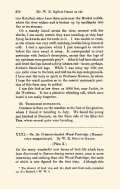
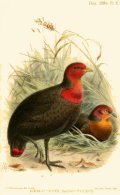 |
|
Notes on the Ornithology of China
F.W. Styan
Colour plate (Pycnonotus taivanus): J.G. Keulemans
Ibis: Volume 36, Issue 3, pages 329-337
1894
Opening lines: "These few notes on the Birds of China I have grouped according to the districts to which they refer, each of these districts having its own more or less characteristic avifauna."
|
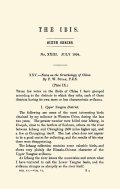
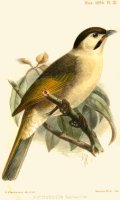 |
|
On the Occurrence of Colymbus adamsi in Norway
Prof. R. Collett
Colour plate (Colymbus adamsi): J.G. Keulemans
Ibis: Volume 36, Issue 2, pages 269-283
1894
Opening lines: "The large Diver first named by G. R. Gray (P. Z. S. 1859, p. 167) Colymbus adamsi, from specimens obtained by Mr. Adams, surgeon of H.M.S. Enterprise, during a voyage of that vessel through Behring Strait, visits the coasts of Norway annually, especially during the autumn and winter, in some years even in considerable numbers, and specimens of it are now preserved in several of the museums of this country. The winter visitors usually appear in October, and most of the specimens hitherto examined have been obtained during the period from October to December. They consist of both young of the year and adults. Of the latter some are one-year-old individuals, which still (in the second winter) continue to bear their grey plumage, and some are in full summer-plumage, or changing from it to the grey winter-plumage of the third year."
|
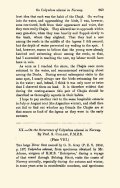
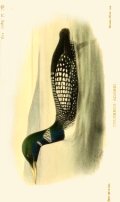 |
|
On a Collection of Birds sent by Mr. Alfred H. Everett from the Sulu Archipelago
R. Bowdler Sharpe
2 colour plate (Prioniturus verticalis / Dicaeum sibutuense and Dicaeum hypoleucum): J.G. Keulemans
Ibis: Volume 36, Issue 2, pages 238-259
1894
Opening lines: "It is with great pleasure that I bring before the readers of 'The Ibis' an account of a small but interesting collection of birds procured in the islands of Bongao; Sibutu, and Tawi-Tawi, in the Sulu Archipelago, by Mr. A. H. Everett. I believe that no birds have been previously obtained from Bongao and Tawi-Tawi, and that only a few odd skins, procured by Sir Hugh Low, have been brought from Sibutu. The main island of Sulu has been visited by Mr. Burbidge, Dr. Guillemard, M. Marche, and Dr. Platen and his wife, and the following papers refer to the ornithology of that island."
|
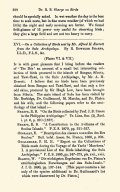
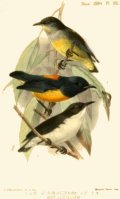 |
|
Description of a new Species of Grebe from Central Peru
Hans, Graf von Berlepsch and Jean Stolzmann
Colour plate (Podiceps taczunowskii): J.G. Keulemans
Ibis: Volume 36, Issue 1, pages 109-112
1894
From the opening lines: "This fine new species we have named in memory of our ever-memorable friend the late Ladislas Taczanowski, who had confounded it with P. calliparaeus, from which, however, it is quite distinct. Of P. taczunowskii we have before us thee males and three females collected by Mr. T. Kalinowski, a correspondent of the Branicki Museum, in the neighbourhood of Incapirca Jezioro, on Lake Junin, 17,700 feet above the sea level, on the 24th and 27th May, 1890. Kalinowski notes the colour of the iris as 'rouge clair,' the legs as 'olivatre plombe' on the inner and 'd'un gris brunatrea on the outer side. He has also sent two eggs of this species, which will be described in a future article."
|
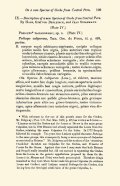
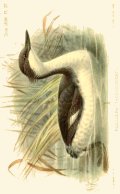 |
|
On some Birds from Bugotu, Solomon Islands, and Santa Cruz
H.B. Tristram
Colour plate (Zosterops metcalfii and Zosterops rendovae): J.G. Keulemans
Ibis: Volume 36, Issue 1, pages 28-31
1894
Opening lines: "Through the kind assistance of my friend Dr. P. H. Metcalfe, I have received two small collections of birds from the Solomon group and its vicinity: one from Santa Cruz, collected for me by Mr. Forrest, of the Melanesian Mission, and the other from Bugotu, collected by the Rev. Dr. Welchman. Both collections, though small, add to our previous knowledge of the avifauna of these islands; and as there are some birds among them which appear to be hitherto undescribed, I venture to send a list of the species, with descriptions and notes."
|
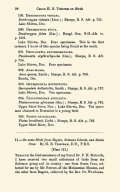
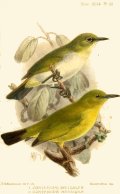 |
|
Second List of Birds collected by Mr. Alexander Whyte, F.Z.S., in Nyasaland
Captain G.E. Shelley
2 colour plates (Xenocichla milanjensis and Xenocichla pusciceps / Phyllostrophus cervinientris and Laniarius bertrandi): J.G. Keulemans
Ibis: Volume 36, Issue 1, pages 1-28
1894
From the opening lines: "My present list, which is based on two collections (of about 1030 specimens together) lately received by Mr. Sclater from Mr. H. H. Johnston, C.B., having been made under his superintendence by Mr. Alexander Whyte, F.Z.S., contains the names of 205 species, of which 102 were not represented in Mr. Whyte's previous collections. Of these 102 species, no less than nine, which I have characterized as follows, appear to me to be new to science."
|
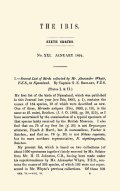
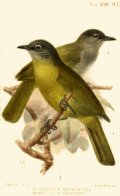 |
|
A List of the Birds inhabiting the Chatham Islands
H.O. Forbes
2 colour plate: J. Smit (Eggs of Chatham Island Birds), J.G. Keulemans (Gallinago pusilla and Thinornis novae-zealandiae)
Ibis: Volume 35, Issue 4, pages 521-546
1893
From the opening lines: "Sir Walter Buller, in the second edition of his History of the Birds of New Zealand, has in most instances mentioned the species found in the Chatham Islands. Since the publication of that work, however, a good deal of additional information has been obtained through the collections made there at the expense of the Hon. Walter Rothschild, and through the exertions of my excellent correspondent Mr. Hawkins, after the visit I was fortunate enough to be able to pay to the islands in January 1892. On that occasion my time was chiefly devoted to the investigation of the extinct avifauna, and I could give but a very small portion of it to the study of the species now living there. I was happily, however, able to persuade Mr. Hawkins, who was my guide and assistant on that occasion, to undertake the task of collecting and observing the species inhabiting the different islands. To his exertions therefore I am indebted for much of the material on which the present communication is founded."
|
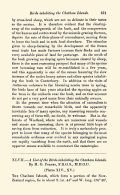
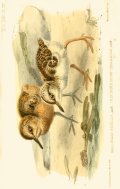 |
|
On the Birds of Hainan
F.W. Styan
Colour plate (Arboricola ardens): J.G. Keulemans
Ibis: Volume 35, Issue 3, pages 424-437
1893
Opening lines: "The island of Hainan lies opposite the extreme southern point of the mainland of China, from which it is separated by a channel only a few miles in breadth. It is about 150 miles long and 50 broad, and is well within the tropics, the 20th parallel passing through its northern extremity. The coast-line is flat, but mountains rise in the interior, forming a high mass in the south-west, from which extend ranges in every direction; one long straight ridge runs north-east through almost the whole length of the island. A considerable part of this mountainous region is inhabited by the Les, an independent aboriginal tribe, who appear to be friendly enough to strangers, but to have little liking for the Chinese, with whom they trade in a small way, but to whom they acknowledge no allegiance."
|
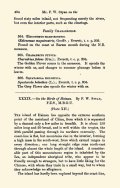
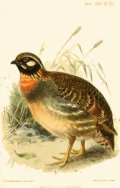 |
|
On the Avifauna of Mount Dulit and the Baram District in the Territory of Sarawak
Charles Hose
2 colour plates (Oriolus hosii / Scops brookii): J.G. Keulemans
Ibis: Volume 35, Issue 3, pages 381-424
1893
Opening lines: "I first began to collect animals in Borneo in 1887, being stimulated to do so by my friend Mr. A. H. Everett, and as I was stationed far in the interior of the island I had opportunities of exploring several portions of the highlands which had previously been unvisited by Europeans. From the very first I received the kindest encouragement from His Highness the Rajah, and it has been a double pleasure to me to occupy my spare time in the exploration of some of the outlying mountains of the Baram District, knowing that the Rajah was as interested as myself in the results of my expeditions. So far the visit I made to Mount Dulit has turned out very satisfactorily, and the novelties have proved to be of remarkable interest; but of course much still remains to be done upon that mountain, and I expect to add considerably to the present list of birds which I have found inhabiting it."
|
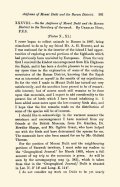
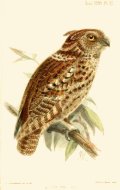 |
|
On the Birds of the Islands of Aruba, Curacao, and Bonaire
Ernst Hartert
Colour plate (Chrysotis ochroptera and Chrysotis rothschildi): J.G. Keulemans
Ibis: Volume 35, Issue 3, pages 289-338
1893
Opening lines: "The three Dutch West-Indian Islands of Aruba, Curacao, and Bonaire are situated off the western part of the north coast of Venezuela. Aruba, being only about 16 miles from Cape San Roman, the north point of the peninsula of Paraguana, is nearest to the continent; Curacao lies about 43 miles to the east; and Bonaire, the most oceanic of the three, still further to the east. Although near to the mainland, these islands do not, like Trinidad, belong geologically to the continent, but are of a different formation. They are surrounded by a coral-limestone belt, and for the most part are covered with a thick coral-limestone capping, and parts of coral-reefs are seen near Willemstad on Curacao, and on the east coast of Bonaire; while Aruba, for almost its entire length on the leeward side, is skirted by a coral-reef, inside of which is a calm and beautifu1 lagoon."
|
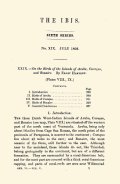
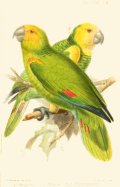 |
|
Notes On Paramythia montium And Amalocichla sclateriana
The Editor
Colour plate (Paramythia montium): J.G. Keulemans
Ibis: Volume 35, Issue 2, pages 243-247
1893
Opening lines: "MR. C. W. De Vis, the Curator of the Queensland Museum, Brisbane, has, with the consent of the Trustees of that Institution, most kindly forwarded to me for examination examples of the two remarkable types of the Papuan Avifauna which he has lately described as Paramythia montium and Amalocichla sclateriana. Of the former of these, which is one of the most remarkable Passerine forms that I have ever seen, I am able to give a figure, and I venture to add a few notes on both of them, which may be acceptable to ornithologists who have not had an opportunity of examining these rare birds."
|
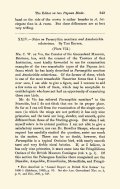
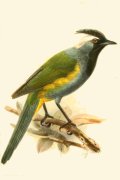 |
|
On A Remarkable New Finch From The Highlands Of Bolivia
Hans, Graf von Berlepsch
Colour plate (Compsospiza garleppi): J.G. Keulemans
Ibis: Volume 35, Issue 2, pages 207-210
1893
Opening lines: "I propose to characterize a new form of the family Fringillidae, from Bolivia, as Compsospiza garleppi."
|
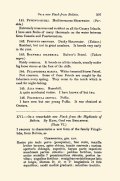
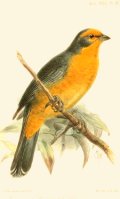 |
|
On the Occurrence of the Sharp-tailed Sandpiper (Tringa acuminata) in Norfolk
Henry Seebohm
Colour plate (Tringa acuminata): J.G. Keulemans
Ibis: Volume 35, Issue 2, pages 181-185
1893
Opening lines: "An example of the Siberian Pectoral or Sharp-tailed Sandpiper, shot on the 29th of August, 1892, at Breydon, near Great Yarmouth, by Mr. T. Ground, has been sent to me for examination by the Editor of 'The Ibis.' It is an adult bird, with most of the underparts marked with dark brown spots, which are small and nearly terminal on the throat and breast, large, subterminal, and squamate on the belly and flanks, and large and lanceolate on the under tail-coverts."
|
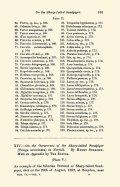
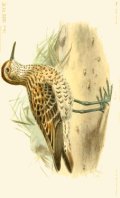 |
|
List of Birds collected by Mr. Alexander Whyte, F.Z.S., in Nyassaland
Captain G.E. Shelley
Preface by The Editor
3 colour plates (Smilorhis Whyti / Hyphantornis bertrandi / Haplopelia johnstoni): J.G. Keulemans
Ibis: Volume 35, Issue 1, pages 1-29
1893
Opening lines: "In the Proceedings of the Zoological Society of London for 1891 will be found a report of the discussion on the new territory called British Central Africa, which was held by the Society on May 5th of that year, and which mainly served to show how little was our knowledge of the fauna of this extensive region. It was then announced on the part of Mr. H. H. Johnston, C.B., F.Z.S., H.B.M. Commissioner, that he wished to make a thorough examination of the fauna, flora, and geology of the new district under his charge, and for that purpose had engaged Mr. Alexander Whyte, F.Z.S., to accompany him as Naturalist and to devote himself to the scientific exploration of the county."
|
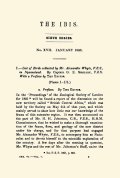
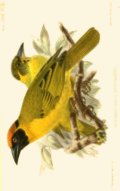 |
|
On the Birds collected by Mr. F. J. Jackson, F.Z.S., during his recent Expedition to Uganda through the Territory of the Imperial British East-African Company: Part V
R. Bowdler Sharpe
Colour plate (Francolinus gedgii): J.G. Keulemans
Ibis: Volume 34, Issue 4, pages 534-322
1892
This is a continuation of a paper that runs over a number of issues.
|
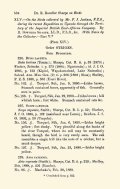
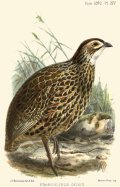 |
|
On a little-known Species of Lark, of the Genus Otocorys
Ernst Hartert
Colour plate (Otocorys berlepschi): J.G. Keulemans
Ibis: Volume 34, Issue 4, pages 522-523
1892
Opening lines: "When preparing the Catalogue of the Birds of the Senckenberg Museum at Frankfurt-a.-M., I found in the Collection a stuffed specimen of a Lark, no doubt belonging to the genus Otocorys. As it was of an entirely unknown species, I briefly described it in the 'Journal fur Ornithologie' under the name of Otocorys berlepschi, calling it after my friend Freiherr Hans von Berlepsch. In my Catalogue of the Birds in the above-named Museum I gave a more careful description of it. This species, however, is so interesting that I wish to introduce it again to the notice of English ornithologists by the accompanying figure, which has been prepared by Mr. Keulemans from a water-colour drawing of the specimen. I add a short description of it."
|
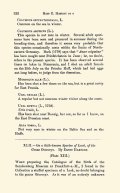
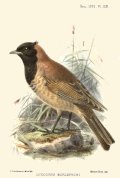 |
|
On Birds collected or observed in the Vicinity of Foochow and Swatow in South-eastern China, Part II
John D. De la Touche
Colour plate (Gallinula coccineipes): J.G. Keulemans
Ibis: Volume 34, Issue 4, pages 477-503
1892
This is a continuation of a paper that was started in an earlier issue.
Opening lines: "Cypselus pacificus, Lath. Swifts with white on the rump, and probably of this species, were seen and shot at by my shooting-men on the Foochow coast at the beginning of June."
|
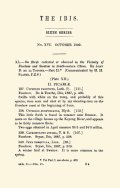
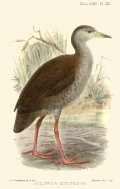 |
|
On a Collection of Birds from Mount Dulit, in North-western Borneo
R. Bowdler Sharpe
2 colour plate (Calyptomena hosii / Mesobucco eximius): J.G. Keulemans
Ibis: Volume 34, Issue 3, pages 430-442
1892
Opening lines: "The very interesting collections made by Mr. John Whitehead on Mount Kina Balu, and described by me in the pages of this Journal, will have prepared the minds of ornithologists for further discoveries in other high mountains of Borneo. That veteran traveller, Mr. A. H. Everett, has already proved, by the small collection made by him on Mount Penrisen, that the species of birds procured by Mr. Whitehead on Kina Balu are not all peculiar to that mountain, and now we know that some of them we to be met with in other localities. As will be seen by the present paper, several of the novelties obtained by Mr. Whitehead are also found on Mount Dulit, and for this interesting disclosure science is indebted to the enterprise of a young Englishman, Mr. Charles Hose, who is already known for his collecting work on the Baram River, where he discovered the remarkable new species of Semnopithecus which bears his name."
|
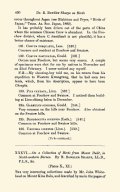
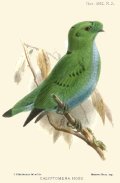 |
|
On the Gallinaceous Genera Bambusicola and Arboricola
W.R. Ogilvie Grant
Colour plate (Arboricola gingica): J.G. Keulemans
Ibis: Volume 34, Issue 3, pages 387-399
1892
Opening lines: "This paper contains a short review of all the known species of the above-named genera, and gives a brief synonymy of them, showing the various combinations of names, generic and specific, which have been used by different authors. It also gives references to all the good figures. Keys to the species and their geographical distribution are added, and numerous notes."
|
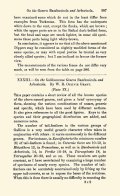
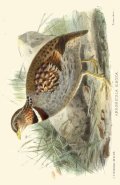 |
|
On a new Species of Flycatcher of the Genus Hyliota
Dr. G. Hartlaub
Colour plate (Hyliota nehrkorni): J.G. Keulemans
Ibis: Volume 34, Issue 3, pages 373-374
1892
Opening lines: "I propose to dedicate to Herr Amtsrath Nehrkorn, of Riddagshausen, a distinct new species of Flycatcher of the genus Hyliota, of which he has sent me an example for examination, and to call it Hyliota nehrkorni."
|
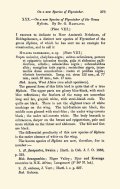
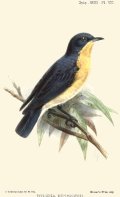 |
|
On the Birds collected by Mr. F. J. Jackson, F.Z.S., during his recent Expedition to Uganda through the Territory of the Imperial British East-African Company: Part IV
R. Bowdler Sharpe
Colour plate (Trochocercus albonotatus and Platystira jacksoni): J.G. Keulemans
Ibis: Volume 34, Issue 2, pages 299-322
1892
Opening lines: "In this paper I conclude the enumeration of the Passeres and Picariae of Mr. Jackson's collection."
|
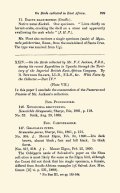
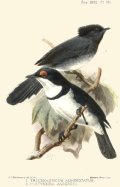 |
|
Notes on the Caprimulgidæ
Ernst Hartert
Colour plate (Caprimulgus eximius): J.G. Keulemans
Ibis: Volume 34, Issue 2, pages 274-288
1892
Opening lines: "Although the Cypselidae and Caprimulgidae are, in my opinion, somewhat allied families, and, in a systematic arrangement, should be placed near together, there can hardly be found a greater difference than in the dull and simple coloration of the plumage of the Swifts, mostly very constant and liable to little variation, and the beautiful and richly coloured plumage of the Goatsuckers, varying in most of the species to a certain extent, and, in some cases, more than in almost any other family of birds."
|
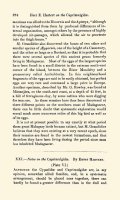
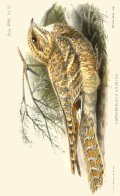 |
|
A List of Birds collected in Corea
C.W. Campbell
Colour plate (Thriponax kalinowskii): J.G. Keulemans
Ibis: Volume 34, Issue 2, pages 230-248
1892
Opening lines: "The collection which forms the subject of this paper was made in 1688 and 1889 during my residence at Soul, the capital of Corea, and at Chemulpo, the western Treaty port."
|
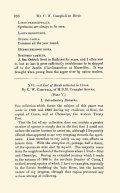
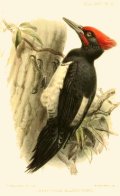 |
|
On the Birds collected by Mr. F. J. Jackson, F.Z.S., during his recent Expedition to Uganda through the Territory of the Imperial British East-African Company: Part III
R. Bowdler Sharpe
Colour plate (Apalis pulchra and Dryodromas jacksoni): J.G. Keulemans
Ibis: Volume 34, Issue 1, pages 152-164
1892
Opening lines: "This third portion of my paper gives a list of Mr. Jackson's collection of Passerine Birds as far as the end of the Turdidae."
|
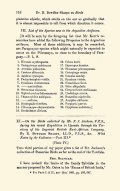
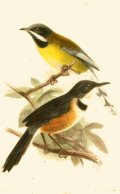 |
|
On the Avifauna of the Lower Pilcomayo
J. Graham Kerr
Colour plate (Celeus kerri): J.G. Keulemans
Ibis: Volume 34, Issue 1, pages 120-152
1892
Opening lines: "The Rio Pilcomayo, as is well known, is one of the chief affluents of the Rio Paraguay from the western side. Rising in the Andes of Bolivia, its course to the south-eastward lies through the heart of 'El Gran Chaco,' an extensive region which has resisted with unusual success most of the numerous attempts at its exploration. As well from its geographical position as from the high-flown fictions which have been written of it by various South-American authors, great hopes were entertained of its turning out a very paradise to the zoologist arid botanist."
|
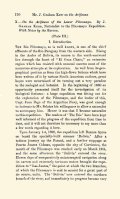
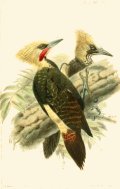 |
|
Description of a new Species of Wren from North-east India, together with an Account of its Nest and Eggs
E.C. Stewart Baker
Colour plate (Elachura haplonota and Elachura punctata): J.G. Keulemans
Ibis: Volume 34, Issue 1, pages 62-64
1892
Opening lines: "I have recently obtained in Northern Cachar an example of a Wren which I believe to be new to science, and propose to
characterize as Elachura haplonota."
|
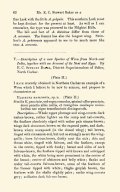
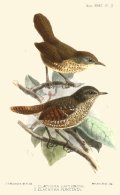 |
|
A short Review of the Francolins belonging to the Genera Francolinus and Pternistes
W.R. Ogilvie Grant
Colour plate (Francolinus jacksoni): J.G. Keulemans
Ibis: Volume 34, Issue 1, pages 32-55
1892
Opening lines: "The following brief review contains a key to all the known species of Francolins. It gives also a short synonymy, which shows, so far as I know, the oldest authority for every combination of generic and specific names ever used for each species, and all references to plates, except in the case of species (such as Francolinus francolinus) which have been frequently figured, when the best only are quoted. The geographical range is stated in every case, and a few notes are added."
|
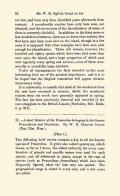
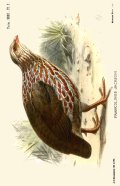 |
|
On the Birds collected by Mr. F. J. Jackson, F.Z.S., during his recent Expedition to Uganda through the Territory of the Imperial British East-African Company
R. Bowdler Sharpe
2 colour plates (Cinnyris reichenowi and Zosterops kikuyuensis / Lanius mackinnoni): J.G. Keulemans
Ibis: Volume 33, Issue 4, pages 587-602
1891
Opening lines: "In this second portion of my description of Mr. Jackson's collection, the families Motacilliae, Certhiidae, Nectariniidae, Zosteropidae, Paridae, and Laniidae are treated of. During my journey back from the Ornithological Congress I stayed a few days in Berlin and Hamburg, and was enabled to compare many of Mr. Jackson's specimens with types collected by Dr. Fischer and Emin Pasha. I have to thank both Dr. Reichenow and Dr. Kraeppelin for their kindness on these occasions, in enabling me to make the necessary examinations."
|
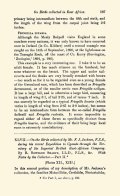
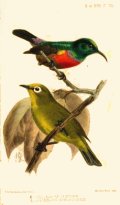 |
|
On the Polynesian Members of the Genus Ptilopus
Lionel W. Wiglesworth
Colour plate (Ptilopus clementinae): J.G. Keulemans
Ibis: Volume 33, Issue 4, pages 566-584
1891
Opening lines: "The Pigeons of the genus Ptilopus, as distributed among the islands of Polynesia, exemplify on a remarkable scale the formation of new species by geographical separation, which is shown in such a striking manner in the Parrots, Blackbirds, and Rhipidurae of the Fiji Islands, and above all in the well-known Land-shells of the family Achatinellidae of the valleys of Oahu. In these cases, however, a narrow projecting mountain-ridge or a few miles of sea are sufficient to prevent the species from interbreeding and losing their identity- as no doubt they would for the most part, could they pass freely from one locality to another; but with the genus Ptilopus a stretch of unbroken ocean 200 or 300 miles wide is required to serve the same end, in consequence of the good powers of flight of these birds."
|
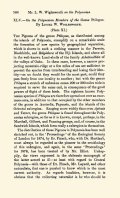
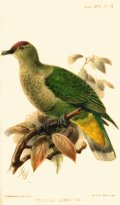 |
|
Remarks on Macgregor's Paradise-bird, Cnemophilus macgregori
P.L. Sclater
Colour plate (Cnemophilus macgregori): J.G. Keulemans
Ibis: Volume 33, Issue 3, pages 414-415
1891
Opening lines: "MR. C. W, De Vis, of the Queensland Museum, Brisbane, has most kindly forwarded to me for examination the typical and unique example of the new Paradise-bird, Cnemophilus macgregori, discovered by Sir William Macgregor's expedition during the ascent of the Owen-Stanley Mountains, and described by Mr. De Vis in the report on Sir W. Macgregor's birds, which has been reprinted in the January number of this Journal (see above, p. 25). I have had the pleasure of showing this beautiful specimen to Count T. Salvadori, Dr. Bowdler Sharpe, and other experienced ornithologists, who all agree with Mr. De Vis that it is a new and very distinct form, and well worthy of generic separation from other known birds."
|
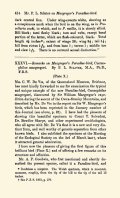
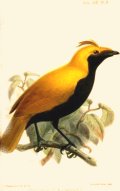 |
|
Note on the Collared Petrel (Estrelata torquata) recently reported to have been killed on the Welsh Coast
Osbert Salvin
Colour plate (Estrelata torquata): J.G. Keulemans
Ibis: Volume 33, Issue 3, pages 411-414
1891
Opening lines: "In the 'Zoologist' for December last (1890, p. 454), Mr. Harting gave a short account of a Petrel a specimen of which had been submitted to him for identification by Mr. J. W. Willis Bund. The same specimen has since been sent to me by our Editor, with a request that I would write a few notes on it and on the species to which it belongs, to accompany the figure of it that it has been thought desirable to place before the readers of 'The Ibis'."
|
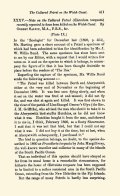
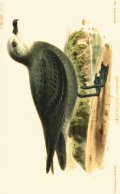 |
|
Ornithological Results of an Expedition to the Philippine Islands in 1887 and 1888
J.B. Steere
2 colour plates (Ptilocichla basilanica / Irena ellae): J.G. Keulemans
Ibis: Volume 33, Issue 3, pages 301-316
1891
Opening lines: "The Steere Expedition to the Philippines went out from the University of Michigan in the year 1887, and spent about twelve months in the islands. The object of the expedition was to make general zoological collections, and at the same time to examine as many distinct localities as possible, so that the distribution of species in the various islands might be studied. Fifteen of the larger islands, situated in all parts of the group, were visited, and from two to six weeks spent upon each. This amount of time, with a party of five collectors from the United States, and such native help as could be obtained, sufficed to make very large, though by no means exhaustive, collections of vertebrates, and important collections in several groups of invertebrates."
|
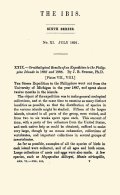
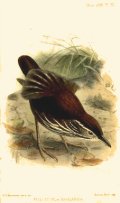 |
|
On the Birds collected by Mr. F. J. Jackson, F.Z.S., during his recent Expedition to Uganda through the Territory of the Imperial British East-African Company
R. Bowdler Sharpe
3 colour plates (Galeopear salvadorii / Drepanoplectes jacksoni / Sycobrotus insignis and Heterhyphantes stephanophorus): J.G. Keulemans
Ibis: Volume 33, Issue 2, pages 233-260
1891
Opening lines: "It is with great pleasure that I lay before the readers of 'The Ibis' an account of one of the most interesting collections of birds that have ever been sent from Africa. Mr. Jackson is already well known to us from the good scientific work that he has done in the Kilimandjaro district and on the Lamu coast (cf. Shelley, Ibis, 1888, pp. 287-307). But the present collection comes as quite a surprise upon all students of African Ornithology, for it seems to open up a totally new idea of the affinities of the fauna of this part of the continent. After studying it I am indeed afraid that all our notions as to the existence of definite zoological subregions in Africa will have to be reconsidered."
|
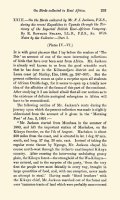
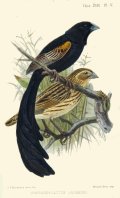 |
|
On a rare Species of Lorikeet in the Rothschild Collection
T. Salvadori
Colour plate (Cryptolopha nigrorum and Abrornis olivacea): J.G. Keulemans
Ibis: Volume 33, Issue 1, pages 48-51
1891
Opening lines: "One of the most obscure and less-known Lorikeets is, no doubt, Loriculus bonapartei. It was described by De Souance in the 'Revue et Magasin de Zoologie' for 1856, p. 222, as having been obtained from the Sooloo Islands; he says that the type-specimens had bcen collected during the 'Voyage au Pole Sud,' but that Hombron and Jacquinot had omitted to mention them in their account of the birds collected during that celebrated expedition, probably having mistaken thcm for some other well-known species."
|
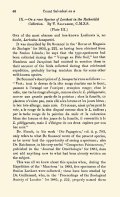
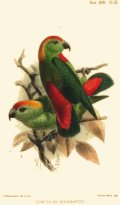 |
|
Descriptions of two new Species of Flycatchers from the Island of Negros, Philippines
E.L.Moseley
Colour plate (Cryptolopha nigrorum and Abrornis olivacea): J.G. Keulemans
Ibis: Volume 33, Issue 1, pages 46-47
1891
Opening lines: "The specimens upon which these species are based were obtained on a mountain-trip in the island of Negros during my recent expedition with Professor Steere to the Philippine Archipelago. There was no human habitation within five miles of the locality where I shot them, the country being too rugged for inhabitants. We had constantly to use our hands in getting up or down the sides of the valley in which we swung our hammocks under a temporary roof for two nights. The valley seems to be the crater of an extinct volcano, the bottom of which is occupied by a deep lake of clear water, but without outlet and without fish, though containing many other forms of life."
|
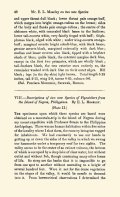
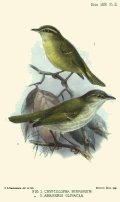 |
|
On some Birds from South-eastern China, with Descriptions of two new Species
Henry H. Slater
Colour plate (Aethopyga latouchii): J.G. Keulemans
Ibis: Volume 33, Issue 1, pages 41-45
1891
Opening lines: "I have been favoured by Mr. J. D. de La Touche with a small parcel of Chinese birds from the vicinity of Swatow and Foochow for examination. All of these are of much interest, arid two of them apparently belong to undescribed species, whilst one or two others call for special notice."
|
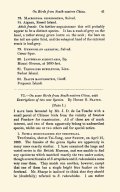
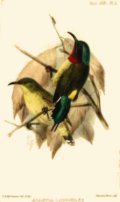 |
|
Notes on some Birds obtained at Madeira, Deserta Grande, and Porto Santo
W.R. Ogilvie Grant
Colour plate (Accipiter granti): J.G. Keulemans
Ibis: Volume 32, Issue 4, pages 438-445
1890
Opening lines: "It was my good fortune to be invited during the spring of this year to accompany a friend on a five weeks' trip to Madeira, and, having never visited that beautiful island, I gladly embraced the opportunity, and determined, if possible, to obtain there a number of birds which were much wanted for the British Museum Collection. I certainly never dreamed of finding anything new, least of all in the birdline, and the handsome new Sparrow-Hawk so excellently delineated by Mr. Keulemans in the accompanying Plate was an unexpected surprise."
|
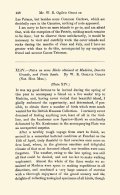
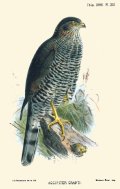 |
|
Further Notes on the Birds of the Canary Islands
E.G. Meade-Waldo
Colour plate (Parus ombriosus): J.G. Keulemans
Ibis: Volume 32, Issue 4, pages 429-438
1890
Opening lines: "I am afraid that I have much less to relate of these islands, ornithologically, this time thau in my previous papers, having recently explored only the little island of Hierro, which is but a small field, and Lanzarote, that resembles the worst parts (for birds) of Fuerteventura."
|
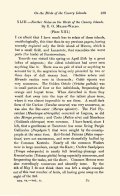
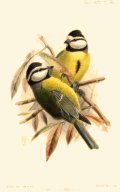 |
|
Notes on Birds from the Papuan Region, with Descriptions of some new Species
Dr. A.B. Meyer
Colour plate (Craspedophora duivenbodei): J.G. Keulemans
Ibis: Volume 32, Issue 4, pages 412-424
1890
Opening lines: "The Dresden Museum has recently received, from several sources and from different parts of New Guinea and New Britain, a series of birds, on which I beg leave to offer the following remarks. I do not propose to give a complete list of the species, but only to mention such as present something new as regards their countries, their native names, their plumages, or their specific differences. In their nomenclature I follow Salvadori's standard work on Papuan ornithology as nearly as possible."
|
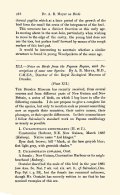
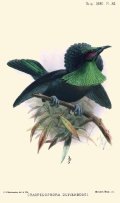 |
|
On Some New And Rare Francolins
W.R. Ogilvie Grant
2 colour plate (Francolinus griseo-striatus / Francolinus castaneicollis): J.G. Keulemans
Ibis: Volume 32, Issue 3, pages 345-350
1890
Opening lines: "Having lately been at work on the Francolins with the view of a complete revision of this rather difficult genus of the Gallinae, I beg leave to offer to the readers of 'The Ibis' some remarks on some new or little-known species of this group."
|
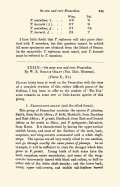
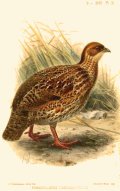 |
|
On a new Finch from Midway Island, North Pacific
Scott B. Wilson
Colour plate (Telespiza cantans): J.G. Keulemans
Ibis: Volume 32, Issue 3, pages 339-344
1890
Opening lines: "The specimen from which the present figure is taken was brought by me alive from Honolulu in January 1889. About March of the preceding year, a small schooner named the 'Mary Bohm' arrived in the Hawaiian Islands from Japan, off the coasts of which country it had been engaged in a fishing venture. Having met with many mishaps, the vessel put into port at Midway Island, where there is a good harbour. At Midway Island, which is uninhabited, Capt. Bohm and his companions found a species of Finch common among the scrubby bushes which cover its surface. It was so tame that it could be easily taken by the hand, and about sixty specimens were captured."
|
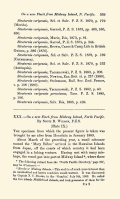
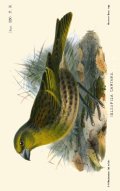 |
|
On the Ornithology of Northern Borneo
R. Bowdler Sharpe
With notes by John Whitehead
Colour plate (Dicaeum monticola and Zosterops clara): J.G. Keulemans
Ibis: Volume 32, Issue 3, pages 273-292
1890
This is a continuation of a paper from an earlier issue.
Opening lines: "I have come to the end of my description of Mr. Whitehead's grand collection, and I have now only to present to the readers of 'The Ibis' a resume of the scientific results of this memorable expedition. To do this in the most comprehensible manner, I have borrowed a leaf from the book of my friend Mr. Osbert Salvin, F.R.S., whose comparative tables of the avifauna of Cozumel and the other islands of the Bay of Honduras (Ibis, 1890, pp. 86-89) gave such a concise view of the zoo-geographical relations of those islands with the neighbouring continent, that I feel that I cannot do better than imitate it."
|
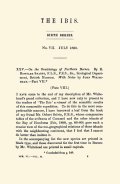
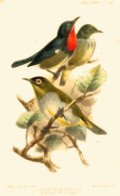 |
|
On some of the Birds of the Sandwich Islands
Scott Wilson
Colour plate (Hemignathus Hanapepe and Hemignathus stejnegeri): J.G. Keulemans
Ibis: Volume 32, Issue 2, pages 170-196
1890
Opening lines: "It may be advantageous to preface these notes by a few geographical remarks as well as by a slight sketch of the leading physical features of the islands of the Hawaiian group, and especially of their forests, with which the existence of their feathered inhabitants is so closely bound up that the destruction of the one involves the extinction of the other. It is, alas! only too probable that both are doomed in a very near future, so that these notes will possess a melancholy interest for naturalists; but it will be quite needless for me to add another to the many descriptions already published of these lovely islands."
|
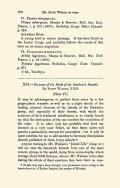
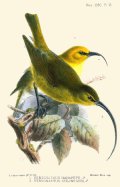 |
|
On a Collection of Birds made by the late Mr. J. S. Jameson on the Aruwhimi River, Upper Congo
Captain G.E. Shelley
Colour plate (Pholidornis jamesoni and Cossypha berttaloti): J.G. Keulemans
Ibis: Volume 32, Issue 2, pages 156-170
1890
Opening lines: "In 1882 I had the pleasure of describing Mr. Jameson's ornithological collections from Matabele Land. It is with the greatest regret that I now have to give a final list of the birds obtained by this ardent young naturalist during his residence at Yambuya, on the Upper Congo, where he was stationed with the rear guard of the Stanley Expedition for the relief of Emin Pasha. His untimely death has been a loss to science, which naturalists will regret equally with the loss of those scientific pioneers of ornithology in Eastern Africa, Drs. G. A. Fischer and R. Bohm, both cut off in their prime, when there was every reason to expect that their work had only just commenced."
|
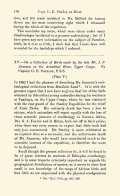
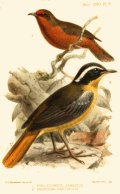 |
|
On the Ornithology of Northern Borneo
R. Bowdler Sharpe
With notes by John Whitehead
Colour plate (Bambusicola erythrophrys): J.G. Keulemans
Ibis: Volume 32, Issue 2, pages 133-149
1890
This is a continuation of a paper from an earlier issue.
Opening lines: "Treron cupellei [Common in forests, frequenting high trees, where it obtains its food. This Pigeon has a peculiarly harsh call; ln fact all the species of this genus that have come under my observation have peculiarly disagreeable notes. Native name 'Puni lanquok.' Iris black; bill pea-green; feet king's yellow."
|
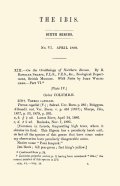
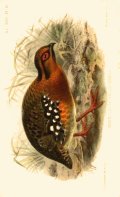 |
|
Notes on the Island of Palma in the Canary Group
H.B. Tristram
Colour plate (Fringilla palmae): J.G. Keulemans
Ibis: Volume 32, Issue 1, pages 67-76
1890
Opening lines: "Mr. Meade-Waldo concludes his interesting paper in the last 'Ibis,' on the 'Birds of the Canary Islands,' by expressing his surprise that he has found so much to tell after all that has been written upon them. I can only follow him by the confession that I feel he has exhausted the subject, and that were it not for the imperative order of our Editor, I should not have ventured to take up my pen. The island of Palma certainly claims especial notice at the hands of the ornithologist, from its peculiar features, from what it does possess in the way of bird-life, and from what it does not possess."
|
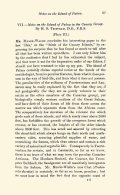
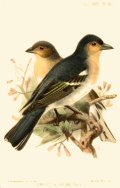 |
|
Notes on the Birds of Palawan
John Whitehead
Colour plate (Baza leucopais): J.G. Keulemans
Ibis: Volume 32, Issue 1, pages 38-61
1890
Opening lines: "I left Labuan on 18th June, 1887, in a small trading steamer belonging to a Chinaman who had several stores on the southern end of Palawan. The steamer landed us at Taguso, on the S.E. coast (many miles south of Puerto Princesa), promising to return in two and a half months; but as she did not turn up until nearly four, I was unable to change my collecting-ground to the N.W. coast, as I had intended. When we landed in Taguso there mere no Spaniards there, and the natives were doing much as they liked. Palawan is notorious for the bad characters which have taken refuge there from the Sulu and other islands; and twice since I have been in the 'Far East' have the Sulus murdered the Chinese and sacked their stores."
|
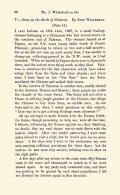
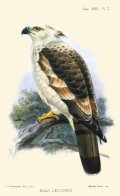 |
|
On The Coloration Of The Young In The Psittacine Genus Eclectus
Dr. A.B. Meyer
Colour plate (Eclectus roratus): J.G. Keulemans
Ibis: Volume 32, Issue 1, pages 26-29
1890
Opening lines: "The colour of the young of those species of the genus Eclectus in which the males are green and the females red has often been discussed, and every possible opinion has been maintained by various writers. I myself have had at different times very different and erroneous notions on this question, which, however, I believe I have settled definitely in my paper 'Ueber die Farbung der Nestjungen von Eclectus, Wagl'."
|
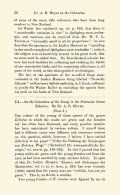
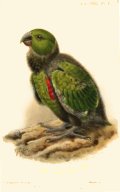 |
|